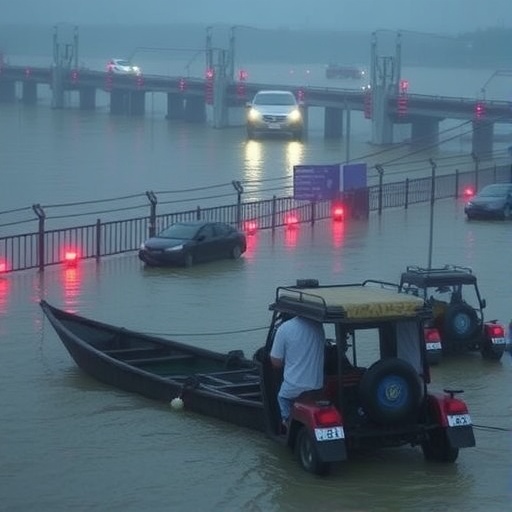Sinking land is increasingly recognized as a growing threat to urban infrastructure, particularly in India’s most populous cities. Researchers from Virginia Tech have uncovered concerning evidence that the over-extraction of groundwater is causing significant land subsidence, with dire consequences for both buildings and their inhabitants. This revelation comes from a recent study co-authored by Susanna Werth, an assistant professor of geosciences, published in the esteemed journal, Nature Sustainability, on October 28, 2025.
Groundwater overuse has emerged as one of the primary drivers of land subsidence. The research indicates that when urban areas extract more water from aquifers than can be naturally replenished, the ground literally sinks beneath these cities. The researchers utilized advanced satellite radar technology to monitor and assess ground movements across five major Indian metropolises: New Delhi, Mumbai, Chennai, Kolkata, and Bengaluru. This study spans a significant timeframe, analyzing data gathered between 2015 and 2023, capturing the impacts of urbanization on land stability.
As cities grow and demand for water resources escalates, the rate of groundwater depletion has accelerated dangerously. The Virginia Tech scientists discovered that approximately 878 square kilometers of urban land is sinking, affecting around 1.9 million residents. Alarming statistics reveal that these individuals are exposed to subsidence rates exceeding four millimeters annually. This phenomenon presents a dire risk not only to the physical safety of the structures in these regions but also to the lives relying on them.
The research highlights that with current subsidence trends continuing, an alarming number of buildings—estimated to be around 2,406—are already at a high risk of structural damage. More startling is the projection that within the next five decades, over 23,000 buildings could face an elevated risk of severe structural failure if decisive action is not taken. The implications of such predictions are dire, underscoring the urgent need for improved groundwater management and infrastructure resilience.
As cities continue to grapple with climate change-induced challenges, the risks from flooding and earthquakes are compounded by land subsidence. Uneven sinking of the ground can jeopardize the foundational integrity of buildings, disrupt utility lines, and heighten overall vulnerability to natural disasters. The research team’s conclusion serves as a wake-up call for policymakers to seriously rethink and adapt urban infrastructure and groundwater usage regulations.
In discussing the findings, lead author Nitheshnirmal Sadhasivam emphasized the potential consequences of ignoring these silent but significant strains on urban landscapes. The study underscores the intersection of resource management and urban planning, advocating for restorative measures in groundwater policies. An immediate shift is crucial to preserve the integrity of urban centers before these challenges escalate into uncontrollable disasters.
Co-author Manoochehr Shirzaei, an associate professor, further elaborated on the transformative role of satellite technology in understanding urban risks. The innovative approach adopted in this study reveals dangers often hidden from view, emerging only when structural collapse occurs. This presents a compelling argument for investing in adaptive strategies, such as enhanced regulatory frameworks and proactive monitoring systems, to safeguard urban populations in India and beyond.
Importantly, the implications of this research extend far beyond the Indian context. The findings resonate with a global urban audience, highlighting that subsidence-related structural damage presents a burgeoning challenge in cities worldwide. As urban centers expand and rely increasingly on strained aquifers, the looming threat of subsidence threatens to undermine infrastructural resilience on a global scale.
The juxtaposition of rapid urban expansion against the pressing need for sustainable groundwater practices raises questions about the balance needed between development and environmental stewardship. Scientific inquiry such as this study serves as a beacon for cities worldwide, encouraging urban planners, policymakers, and citizens to reflect on the sustainability of their water usage practices.
Moreover, integrating modern technology into traditional urban planning methods can yield substantial long-term benefits. As cities grapple with resource scarcity issues, harnessing tools such as satellite radar can offer innovative insights into land stability, helping to avert potential disasters before they manifest. Strengthening the nexus between scientific research and practical application is essential in building cities that not only grow but thrive sustainably.
In conclusion, the findings from Virginia Tech researchers present a crucial reminder of the intrinsic link between groundwater management and urban resilience in the face of changing climate dynamics. Proactive measures and innovative solutions are paramount in preventing the silent strain of sinking land from evolving into catastrophic urban disasters. This study not only sheds light on an immediate crisis in India but also serves as a cautionary tale for urban centers around the globe as they navigate the complexities of modern growth in an increasingly uncertain environmental landscape.
Subject of Research: Groundwater overuse and land subsidence in urban India
Article Title: Sinking Land: A Silent Threat to Urban Infrastructure in India
News Publication Date: October 28, 2025
Web References: https://www.nature.com/articles/s41893-025-01663-0
References: DOI 10.1038/s41893-025-01663-0
Image Credits: Photo courtesy of Virginia Tech
Keywords
Urban infrastructure, Groundwater management, Land subsidence, Climate change, Satellite technology, Infrastructure resilience, Urban planning, Disaster risk management, Sustainable development, Environmental stewardship.




